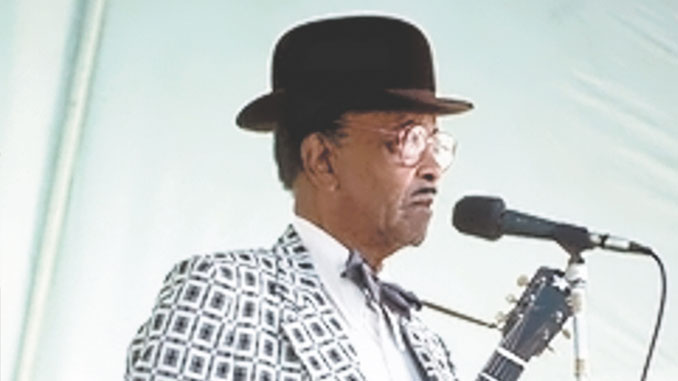
The Danny Barker Banjo and Guitar Festival 2018 completed a six-day run in New Orleans January 9, 2018 through January 14, 2018 – offering a mix of school clinics, workshops, panel discussions, interviews, films and live music performances at a variety of venues, including the New Orleans Jazz Museum, the Ellis Marsalis Center for Music, Snug Harbor, Rhodes Family Services, Bullet’s Sports Bar, Prime Example, Kermit’s Treme’ Mother-in-Law Lounge, NOCCA, UNO and the George and Joyce Wein Center. The live music performances featured an all-star array of New Orleans artists – and international special guests – including legendary Haitian Guitarist and Educator Claude Carre` (www.claudecarre.com) and Senegalese Kora Master Morikeba Kouyate.
The mission of the Danny Barker Banjo and Guitar Festival is to showcase and highlight the many contributions and accomplishments of NEA Jazz Master Danny Barker: Musician, singer, songwriter, raconteur extraordinaire and author – who played guitar and banjo with many top jazz artists over the course of his 70 year plus career – and served as a mentor to numerous young New Orleans artists who have since come to prominence, including Wynton Marsalis, Herlin Riley, Leroy Jones, Gregg Stafford, Dr. Michael White and Lucien Barbarin.
Who was Danny Barker?
Born Daniel Moses Barker (January 13, 1909 – March 13, 1994), Barker was an American jazz musician, vocalist, and author from New Orleans. He was a rhythm guitarist for various bands of the day, including Cab Calloway, Lucky Millinder and Benny Carter throughout the 1930s.
One of Barker’s earliest teachers in New Orleans was fellow banjoist Emanuel Sayles, with whom he recorded. Throughout his career, he played with Jelly Roll Morton, Baby Dodds, James P. Johnson, Sidney Bechet, Mezz Mezzrow, and Red Allen. He also toured and recorded with his wife, singer Blue Lu Barker. From the 1960s, Barker’s work with the Fairview Baptist Church Brass Band was pivotal in ensuring the longevity of jazz in New Orleans, producing generations of new talent, including Wynton and Branford Marsalis who played in the band as youths.
Barker began his career as a musician in his youth with his streetband the Boozan Kings, and also toured Mississippi with Little Brother Montgomery. In 1930 he moved to New York City and switched to the guitar. On the day of his arrival in New York, his uncle Paul took him to the Rhythm Club, where he saw an inspiring performance by McKinney’s Cotton Pickers. It was their first performance in New York as a band.
Barker played with several acts when he moved to New York, including Fess Williams, Billy Fowler and the White Brothers. He worked with Buddy Harris in 1933, Albert Nicholas in 1935, Lucky Millinder from 1937 to 1938, and Benny Carter in 1938. During his time in New York, he frequently played with West Indian musicians, who often mistook him for one of them due to his Creole style of playing.
From 1939 to 1946 he frequently recorded with Cab Calloway, and started his own group featuring his wife Blue Lu Barker after leaving Calloway. On September 4, 1945 he recorded with Ohio’s native jazz pianist, Sir Charles Thompson, and saxophonists Dexter Gordon and Charlie Parker. [1] In 1947 he was performing again with Lucky Millinder, and also with Bunk Johnson. He returned to working with Al Nicholas in 1948 and in 1949 rejoined efforts with his wife in a group.
During the 1950s he was primarily a freelance musician, but did work with his uncle Paul Barbarin from 1954 to 1955. In the mid-1950s he went to California to record again with Albert Nicholas. [6] He performed at the 1960 Newport Jazz Festival with Eubie Blake. In 1963 he was working with Cliff Jackson, and then in 1964 appeared at the World Fair leading his own group. Sometime in the early 1960s he formed a group he called Cinderella.
In 1965, Barker returned to New Orleans and took up a position as assistant to the curator of the New Orleans Jazz Museum. In 1970 he founded and led a church-sponsored brass band for young people—the Fairview Baptist Church Marching Band—which became popular. Reverend Andrew Darby, Jr., the Pastor of Fairview Baptist Church commissioned ‘Brother’ Barker to form a Christian band, and Barker went throughout the neighborhood of the church enlisting young musicians. The Fairview band launched the careers of a number of professional musicians who went on to perform in brass band and mainstream jazz contexts, including Leroy Jones, Wynton Marsalis, Branford Marsalis, Kirk Joseph, Nicholas Payton, Shannon Powell, Lucien Barbarin, Dr. Michael White and others. As Joe Torregano—another Fairview band alumnus—described it, “That group saved jazz for a generation in New Orleans.”
In later years the band became known as the Dirty Dozen Brass Band. During that time, he also led the French Market Jazz Band.
Barker played regularly at many New Orleans venues from the late 1960s through the early 1990s, in addition to touring. During the 1994 Mardi Gras season, Barker reigned as King of Krewe du Vieux. He also published an autobiography and many articles on New Orleans and jazz history.
Barker wrote and had published two books on jazz from the Oxford University Press. The first was Bourbon Street Black, co-written with Dr. Jack V. Buerkle, in 1973, which was followed by A Life In Jazz in 1986. He also enjoyed painting and was an amateur landscape artist.
Living during a period when segregation was still common practice in the United States, Barker faced many obstacles during his career. Barker suffered from diabetes throughout most of his adult life, and died of cancer in New Orleans on 13 March 1994 at age 85.
Recommended For You.



Be the first to comment